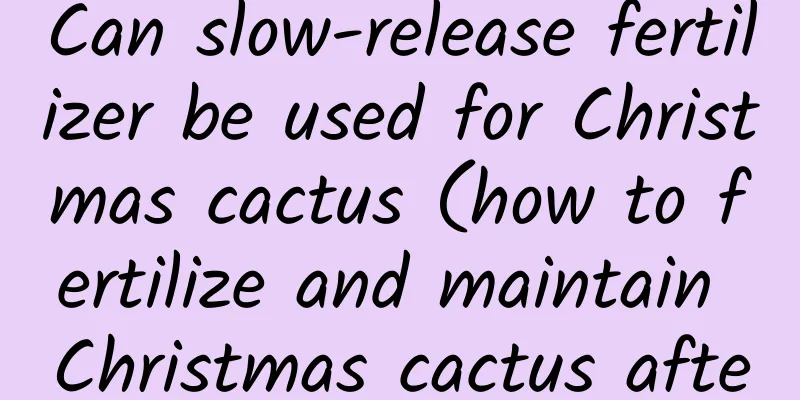Can slow-release fertilizer be used for Christmas cactus (how to fertilize and maintain Christmas cactus after its flowering period)

After the Christmas cactus blooms, you can use slow-release fertilizerSlow-release fertilizer is a resin-coated fertilizer with the characteristics of sustainable release and a long release cycle. It can be used as base fertilizer or applied in holes or directly sprinkled on the surface of potting soil. It will be gradually absorbed by potted plants as watering occurs. Its fertilizer effect is relatively mild, the release cycle is long, and the fertilizer utilization rate and conversion rate are high. It is currently a popular flower fertilizer among flower lovers. Therefore, it can also be used for Christmas cactus that has just finished blooming. Generally, we pay attention to the ratio of nitrogen, phosphorus and potassium when using it, and choose a general slow-release fertilizer with a relatively balanced ratio of nitrogen, phosphorus and potassium. In addition to fertilizing, the maintenance points of Christmas cactus flower after it withersAfter Christmas cactus blooms, the withered flowers should be trimmed in time, and the branches should be shortened by 2-3 sections. This will help reduce nutrient consumption and prevent branch aging. It can also break the apical dominance and promote the growth of new leaves, which is helpful for flowering in the next season. Although Christmas cactus does not need to be repotted every year, it is best to repot and change the soil every 1-2 years. This is beneficial for replenishing nutrients, preventing root aging and soil compaction, and promoting vigorous growth. The root system of Christmas cactus is underdeveloped and it is more prone to aging. Non-grafted Christmas cactus usually grows for 3-5 years before the bottom branches become lignified and the leaves become smaller and smaller, and the quality of flowering declines . Backups can also be reserved through cuttings and grafting to prepare for replacement of the old with the new. Daily care precautions after Christmas cactus bloomsChristmas cactus belongs to the cactus family. It is easy to grow and reproduce, but it is not resistant to high temperatures and severe cold. It needs to avoid long-term direct sunlight during the high temperatures in summer. During the growing and flowering periods, it needs sufficient scattered sunlight. Daily care should avoid water accumulation in the pot and excessive temperature difference between morning and evening to reduce the probability of root rot and falling flower buds. Christmas cactus is not cold-resistant. Its leaves are easily frozen and turned red in low temperatures in winter. Its flower buds are prone to shriveling and falling off when the temperature is below 10℃, making it difficult to guarantee the quality of its flowering. Keeping the pot soil dry and the ambient temperature not lower than 5℃ in winter is conducive to a smooth winter. Fertilization is generally carried out during the bud formation period in autumn and after the flowering period. Pay attention to applying thin fertilizers frequently. |
Recommend
How much is the yield per mu of Angelica dahurica? How much is the profit? Angelica dahurica planting technology and per mu income
The planting prospect of Angelica dahurica is goo...
What to do if the leaves of Jade Butterfly are cracked
reason Jade butterflies are easy to raise, have s...
Can fragrant wood be placed in the bedroom?
1. Smell Its smell is a major reason that influen...
How to grow hibiscus by cuttings? Can cuttings be done in winter?
1. Methods 1. Time: It is usually carried out in ...
Can wintersweet trees be planted in the yard?
Can I plant a wintersweet tree in my yard? Genera...
Tips for rooting lucky tree in water
1. Rooting tips 1. First of all, the pruning proc...
Is the calla lily poisonous?
Is it poisonous? Many people mistake calla lilies...
Bougainvillea longevum... After just one cut, it overflowed the pot and all the leaves were invisible. How did you do that?
How to make Kalanchoe bloom in full bloom? Spring...
Can the lucky tree be watered with rice water? What kind of water is best?
1. Is it possible? Rice water can be used to wate...
How to water azalea in winter
Watering azalea in winter Azalea needs to be wate...
Is North China suitable for growing broad beans (when and how to grow broad beans in North China)
Is North China suitable for growing broad beans? ...
Phalaenopsis maintenance in stages
Phalaenopsis seedling stage maintenance During th...
How to repot and transplant white palm
1. Time to change pots White calla lilies grow re...
Cultivation methods and precautions of red plum blossoms
Red plum blossom is a type of plum blossom. It pr...
How many cosmos should be planted in one pot?
How many cosmos should be planted in one pot? Gen...









